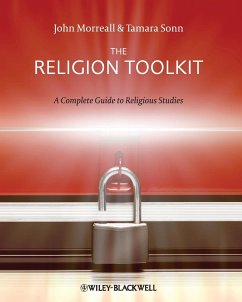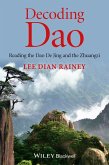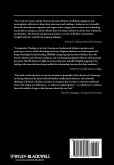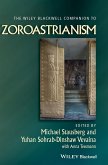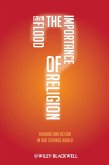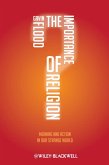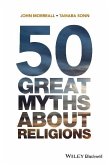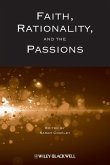- Broschiertes Buch
- Merkliste
- Auf die Merkliste
- Bewerten Bewerten
- Teilen
- Produkt teilen
- Produkterinnerung
- Produkterinnerung
This complete overview of religious studies provides students with the essential knowledge and tools they need to explore and understand the nature of religion. Covers the early development of religion, with overviews of major and minor religions from Islam to Scientology Considers recent developments including secularization; the relationship between religion and science; and scientific studies on religion, health, and mystical experience Uses humor throughout, allowing students to remain open-minded to the subject Explains what it means to study religion academically, and considers the…mehr
Andere Kunden interessierten sich auch für
![Decoding Dao Decoding Dao]() Lee Dian RaineyDecoding Dao104,99 €
Lee Dian RaineyDecoding Dao104,99 €![Towards a Jewish-Christian-Muslim Theology Towards a Jewish-Christian-Muslim Theology]() David B BurrellTowards a Jewish-Christian-Muslim Theology49,99 €
David B BurrellTowards a Jewish-Christian-Muslim Theology49,99 €![The Wiley Blackwell Companion to Zoroastrianism The Wiley Blackwell Companion to Zoroastrianism]() The Wiley Blackwell Companion to Zoroastrianism225,99 €
The Wiley Blackwell Companion to Zoroastrianism225,99 €![The Importance of Religion The Importance of Religion]() Gavin FloodThe Importance of Religion39,99 €
Gavin FloodThe Importance of Religion39,99 €![The Importance of Religion The Importance of Religion]() Gavin FloodThe Importance of Religion107,99 €
Gavin FloodThe Importance of Religion107,99 €![50 Great Myths about Religions 50 Great Myths about Religions]() John Morreall50 Great Myths about Religions33,99 €
John Morreall50 Great Myths about Religions33,99 €![Faith, Rationality and the Passions Faith, Rationality and the Passions]() Faith, Rationality and the Passions40,99 €
Faith, Rationality and the Passions40,99 €-
This complete overview of religious studies provides students with the essential knowledge and tools they need to explore and understand the nature of religion.
Covers the early development of religion, with overviews of major and minor religions from Islam to Scientology
Considers recent developments including secularization; the relationship between religion and science; and scientific studies on religion, health, and mystical experience
Uses humor throughout, allowing students to remain open-minded to the subject
Explains what it means to study religion academically, and considers the impact of the study of religion on religion itself
Contains numerous student-friendly features including photos, maps, time lines, side bars, historical profiles, and population distribution figures
Provides classroom users with a lively website,www.wiley.com/go/religiontoolkit, including questions, quizzes, extra material, and helpful primary and secondary sources
Covers the early development of religion, with overviews of major and minor religions from Islam to Scientology
Considers recent developments including secularization; the relationship between religion and science; and scientific studies on religion, health, and mystical experience
Uses humor throughout, allowing students to remain open-minded to the subject
Explains what it means to study religion academically, and considers the impact of the study of religion on religion itself
Contains numerous student-friendly features including photos, maps, time lines, side bars, historical profiles, and population distribution figures
Provides classroom users with a lively website,www.wiley.com/go/religiontoolkit, including questions, quizzes, extra material, and helpful primary and secondary sources
Produktdetails
- Produktdetails
- Verlag: Wiley & Sons
- 1. Auflage
- Seitenzahl: 376
- Erscheinungstermin: Oktober 2011
- Englisch
- Abmessung: 254mm x 203mm x 20mm
- Gewicht: 805g
- ISBN-13: 9781405182461
- ISBN-10: 1405182466
- Artikelnr.: 32568105
- Herstellerkennzeichnung
- Books on Demand GmbH
- In de Tarpen 42
- 22848 Norderstedt
- info@bod.de
- 040 53433511
- Verlag: Wiley & Sons
- 1. Auflage
- Seitenzahl: 376
- Erscheinungstermin: Oktober 2011
- Englisch
- Abmessung: 254mm x 203mm x 20mm
- Gewicht: 805g
- ISBN-13: 9781405182461
- ISBN-10: 1405182466
- Artikelnr.: 32568105
- Herstellerkennzeichnung
- Books on Demand GmbH
- In de Tarpen 42
- 22848 Norderstedt
- info@bod.de
- 040 53433511
John Morreall is Professor of Religious Studies at the College of William and Mary. He has published widely in the philosophy of religion, and on the comic dimensions of world religions. His book Comedy, Tragedy, and Religion (1999) won the Choice Outstanding Academic Book 2000. He is also the author of Comic Relief: A Comprehensive Philosophy of Humor (2009), published by Wiley-Blackwell. Tamara Sonn is the Wm. R. Kenan Distinguished Professor of Humanities in the Department of Religious Studies at the College of William and Mary. Her books include Comparing Religions through Law: Judaism and Islam (with J. Neusner, 1999) and Islam: A Brief History, 2nd edition (Wiley-Blackwell, 2010). She was senior editor of the Oxford Dictionary of Islam (2003), and associate editor of The Islamic World Past and Present (2004). She is currently an editor of Oxford Islamic Studies Online, and of Encyclopedia of the Islamic World (2009). In addition, Sonn is editor-in-chief of Oxford Bibliographies Online: Islamic Studies, and co-editor-in-chief of Wiley-Blackwell's Religion Compass.
1. Introduction: Prepare To Be Surprised Part I: The Tools 2. An Overview
of Religion: Making Sense of Life A. Explaining Suffering and Evil B.
Explaining Death 1. Ghosts 2. Resurrection 3. Souls 4. Reincarnation C. The
Importance of Order 1. Order Out of Chaos 2. Order and Predictability:
Eschatology, Prophecy, Divination 3. Social Order a. Group Identity
b.Ethics/Morality and Law c. Authority and Power D. The Role of Ritual
E.Conclusion 3. The Early Development of Religious Studies A. Philosophy,
Theology, and Religious Studies 1. The Relationship between Philosophy and
Theology 2. Two Kinds of Christian Theology B. Scriptural (Biblical)
Studies and the Impact of the Printing Press 1. Baruch Spinoza William
Robertson Smith: Historical Criticism C. The Rise of Modernity and New
Academic Disciplines:Oriental Studies, Anthropology, Sociology, and
Psychology 1. Max Müller: Oriental Studies and Religion 2. Edward Burnett
Tylor: Anthropology and Religion 3. James Frazer: Evolution and Religion D.
Negative Views of Religion 1. Karl Marx: Religion and the Opiate of the
Masses 2.Sigmund Freud: Religion and Neurosis E. Sociology of Religion 1.
Emile Durkheim: Modernization Theory 2. Max Weber: The Protestant Ethic F.
Conclusion 4. Religious Studies in the Twentieth Century A. Back to
Philosophy 1. Analytic Philosophy: Antony Flew 2. Phenomenology and
Religious Studies a. Rudolf Otto b. Mircea Eliade B. Philosophy of Religion
1. John Hick 2. William Lane Craig C. Anthropology of Religion 1. Clifford
Geertz 2. Mary Douglas D. Sociology of Religion 1. Peter L. Berger 2.
Robert N. Bellah E. Psychology of Religion 1. Wiliam James 2. Carl Jung
F.Conclusion Part II: Using the Tools: Surveying World Religions 5. Early
Traditions A. Prehistoric Traditions 1. Animism and Anthropomorphism 2.
Death Rituals 3.Fertility Goddesses 4. Hunting Rituals 5. Shamans 6.
Ancient Religions, Oral Religions B. The Neolithic Revolution, Patriarchy,
and the Rise of Historic Religions C. Conclusion 6. The Family of Western
Monotheisms: Jewish, Christian, and Islamic Traditions UNIT I: Judaism A.
The Torah, the Hebrew Bible, the Old Testament B. The History and Teachings
of Judaism 1. The First Five Centuries 2. The Middle Ages(500-1500CE) 3.
The Modern Period (1750 to the present) a. The Enlightenment b.The
Development of Reform Judaism c.Conservative Judaism d. Reconstructionist
Judaism C. The Rituals of Judaism D. Judaism Today UNIT II: Christianity A.
The History and Teachings of Christianity 1. Origins 2. The Development of
Christian Doctrine a. The Institutionalization and Politicization of
Christianity b. Eastern and Western Christians i. The Western/Roman Church
ii The Eastern Orthodox Churches 3. The Protestant Reformation B. Christian
Rituals C. Christianity Today UNIT III: Islam A. The History and Teachings
of Islam 1. Core Teachings Early History: The Life of Muhammad and the
Rashidun Caliphs 3. The Dynastic Caliphates The Modern Period: Reform and
Recovery B. Islamic Rituals C. Major Divisions Today UNIT IV: The Impact of
Religious Studies on the Western Monotheisms A. Biblical Studies 1. Rudolf
Bultmann: "Demythologizing" Scripture 2. John Dominic Crossan: The
Historicity of Scripture B. Theology 1. Liberation Theology Gustavo
Gutierrez Farid Esack 2. Feminist Theology a. Judith Plaskow b. Rosemary
Radford Ruether c. Amina Wadud C. Conclusion 7. Two Traditions of India:
Hinduism and Buddhism A. Hinduism and Buddhism B. Hinduism 1. History and
Teachings of Hinduism a. Indus Valley Civilization (3,000-1,500 BCE) b. The
Aryans and the Vedas (1,500-600 BCE) c. The Mystical Worldview of the
Upanishads d. Classical Hinduism i. The Ramayana ii.The Mahabharata iii.
The Puranas iv. The Laws of Manu 2. Hinduism Today 3. Rituals C. Buddhism
1. History and Teachings of Buddhism a. Understanding the Four Noble Truths
b. The Ethics of "Awakening" c. The Core of All Buddhist Traditions d. The
Development of the Three Main Traditions i. Theravada (Hinayana) ii.
Mahayana iii. Vajrayana 2. Buddhism Today 3. Rituals D. Conclusion:
Religious Studies and Indian Traditions 8. Balancing and Blending:
Confucianism, Daoism, and Buddhism in China A. The Tao, Yin and Yang B. The
History of Chinese Religious Thought 1. The Shang Period (18th-12th c. BCE)
The Zhou Period (12th-3rd c. BCE) C.Confucius D. Taoism E. Buddhism in
China 1. Pure Land Buddhism 2. Chan (Zen) Buddhism F. Chinese Folk
Traditions G. Chinese Traditions Today 9. Zoroastrianism, Shinto, Baha'i,
Scientology, Wicca, and the Seneca: What Makes a "World Religion"? A. What
Makes a "World Religion"? B. Zoroastrianism 1. History and Teachings of
Zoroastrianism 2. Zoroastrian Rituals C. Shinto 1. History and Teachings of
Shinto 2. Shinto Rituals D. Baha'i 1. History and Teachings of Baha'i 2.
Baha'i Rituals E. Scientology 1. History and Teachings of Scientology 2.
Scientology Practices 3. Scientology Rituals F. Wicca 1. History and
Teachings of Wicca 2. Wiccan Rituals G. The Traditions of the Seneca 1.
History and Teachings of the Seneca 2. Seneca Traditions H. Conclusion: To
Be or Not To Be a Religion? 10. Closing Question A. Can We Define Religion?
B.Secularization? 1. Contemporary Atheist Views 2. Contemporary Opposition
to Secularization Theory a. Resurgent Islam b. Resurgent Religion in the
U.S.? c. Secularization in Europe 3. Religion Revisited C. Other Issues 1
The Range of Research Areas in the American Academy of Religion 2. Medical
Science and Religion a. Religion and Physical Health c. Religion and Mental
Health d. Does Prayer Work? e. Brain Science and Mystical Experience D.
Conclusion: Another Surprise?
of Religion: Making Sense of Life A. Explaining Suffering and Evil B.
Explaining Death 1. Ghosts 2. Resurrection 3. Souls 4. Reincarnation C. The
Importance of Order 1. Order Out of Chaos 2. Order and Predictability:
Eschatology, Prophecy, Divination 3. Social Order a. Group Identity
b.Ethics/Morality and Law c. Authority and Power D. The Role of Ritual
E.Conclusion 3. The Early Development of Religious Studies A. Philosophy,
Theology, and Religious Studies 1. The Relationship between Philosophy and
Theology 2. Two Kinds of Christian Theology B. Scriptural (Biblical)
Studies and the Impact of the Printing Press 1. Baruch Spinoza William
Robertson Smith: Historical Criticism C. The Rise of Modernity and New
Academic Disciplines:Oriental Studies, Anthropology, Sociology, and
Psychology 1. Max Müller: Oriental Studies and Religion 2. Edward Burnett
Tylor: Anthropology and Religion 3. James Frazer: Evolution and Religion D.
Negative Views of Religion 1. Karl Marx: Religion and the Opiate of the
Masses 2.Sigmund Freud: Religion and Neurosis E. Sociology of Religion 1.
Emile Durkheim: Modernization Theory 2. Max Weber: The Protestant Ethic F.
Conclusion 4. Religious Studies in the Twentieth Century A. Back to
Philosophy 1. Analytic Philosophy: Antony Flew 2. Phenomenology and
Religious Studies a. Rudolf Otto b. Mircea Eliade B. Philosophy of Religion
1. John Hick 2. William Lane Craig C. Anthropology of Religion 1. Clifford
Geertz 2. Mary Douglas D. Sociology of Religion 1. Peter L. Berger 2.
Robert N. Bellah E. Psychology of Religion 1. Wiliam James 2. Carl Jung
F.Conclusion Part II: Using the Tools: Surveying World Religions 5. Early
Traditions A. Prehistoric Traditions 1. Animism and Anthropomorphism 2.
Death Rituals 3.Fertility Goddesses 4. Hunting Rituals 5. Shamans 6.
Ancient Religions, Oral Religions B. The Neolithic Revolution, Patriarchy,
and the Rise of Historic Religions C. Conclusion 6. The Family of Western
Monotheisms: Jewish, Christian, and Islamic Traditions UNIT I: Judaism A.
The Torah, the Hebrew Bible, the Old Testament B. The History and Teachings
of Judaism 1. The First Five Centuries 2. The Middle Ages(500-1500CE) 3.
The Modern Period (1750 to the present) a. The Enlightenment b.The
Development of Reform Judaism c.Conservative Judaism d. Reconstructionist
Judaism C. The Rituals of Judaism D. Judaism Today UNIT II: Christianity A.
The History and Teachings of Christianity 1. Origins 2. The Development of
Christian Doctrine a. The Institutionalization and Politicization of
Christianity b. Eastern and Western Christians i. The Western/Roman Church
ii The Eastern Orthodox Churches 3. The Protestant Reformation B. Christian
Rituals C. Christianity Today UNIT III: Islam A. The History and Teachings
of Islam 1. Core Teachings Early History: The Life of Muhammad and the
Rashidun Caliphs 3. The Dynastic Caliphates The Modern Period: Reform and
Recovery B. Islamic Rituals C. Major Divisions Today UNIT IV: The Impact of
Religious Studies on the Western Monotheisms A. Biblical Studies 1. Rudolf
Bultmann: "Demythologizing" Scripture 2. John Dominic Crossan: The
Historicity of Scripture B. Theology 1. Liberation Theology Gustavo
Gutierrez Farid Esack 2. Feminist Theology a. Judith Plaskow b. Rosemary
Radford Ruether c. Amina Wadud C. Conclusion 7. Two Traditions of India:
Hinduism and Buddhism A. Hinduism and Buddhism B. Hinduism 1. History and
Teachings of Hinduism a. Indus Valley Civilization (3,000-1,500 BCE) b. The
Aryans and the Vedas (1,500-600 BCE) c. The Mystical Worldview of the
Upanishads d. Classical Hinduism i. The Ramayana ii.The Mahabharata iii.
The Puranas iv. The Laws of Manu 2. Hinduism Today 3. Rituals C. Buddhism
1. History and Teachings of Buddhism a. Understanding the Four Noble Truths
b. The Ethics of "Awakening" c. The Core of All Buddhist Traditions d. The
Development of the Three Main Traditions i. Theravada (Hinayana) ii.
Mahayana iii. Vajrayana 2. Buddhism Today 3. Rituals D. Conclusion:
Religious Studies and Indian Traditions 8. Balancing and Blending:
Confucianism, Daoism, and Buddhism in China A. The Tao, Yin and Yang B. The
History of Chinese Religious Thought 1. The Shang Period (18th-12th c. BCE)
The Zhou Period (12th-3rd c. BCE) C.Confucius D. Taoism E. Buddhism in
China 1. Pure Land Buddhism 2. Chan (Zen) Buddhism F. Chinese Folk
Traditions G. Chinese Traditions Today 9. Zoroastrianism, Shinto, Baha'i,
Scientology, Wicca, and the Seneca: What Makes a "World Religion"? A. What
Makes a "World Religion"? B. Zoroastrianism 1. History and Teachings of
Zoroastrianism 2. Zoroastrian Rituals C. Shinto 1. History and Teachings of
Shinto 2. Shinto Rituals D. Baha'i 1. History and Teachings of Baha'i 2.
Baha'i Rituals E. Scientology 1. History and Teachings of Scientology 2.
Scientology Practices 3. Scientology Rituals F. Wicca 1. History and
Teachings of Wicca 2. Wiccan Rituals G. The Traditions of the Seneca 1.
History and Teachings of the Seneca 2. Seneca Traditions H. Conclusion: To
Be or Not To Be a Religion? 10. Closing Question A. Can We Define Religion?
B.Secularization? 1. Contemporary Atheist Views 2. Contemporary Opposition
to Secularization Theory a. Resurgent Islam b. Resurgent Religion in the
U.S.? c. Secularization in Europe 3. Religion Revisited C. Other Issues 1
The Range of Research Areas in the American Academy of Religion 2. Medical
Science and Religion a. Religion and Physical Health c. Religion and Mental
Health d. Does Prayer Work? e. Brain Science and Mystical Experience D.
Conclusion: Another Surprise?
1. Introduction: Prepare To Be Surprised Part I: The Tools 2. An Overview
of Religion: Making Sense of Life A. Explaining Suffering and Evil B.
Explaining Death 1. Ghosts 2. Resurrection 3. Souls 4. Reincarnation C. The
Importance of Order 1. Order Out of Chaos 2. Order and Predictability:
Eschatology, Prophecy, Divination 3. Social Order a. Group Identity
b.Ethics/Morality and Law c. Authority and Power D. The Role of Ritual
E.Conclusion 3. The Early Development of Religious Studies A. Philosophy,
Theology, and Religious Studies 1. The Relationship between Philosophy and
Theology 2. Two Kinds of Christian Theology B. Scriptural (Biblical)
Studies and the Impact of the Printing Press 1. Baruch Spinoza William
Robertson Smith: Historical Criticism C. The Rise of Modernity and New
Academic Disciplines:Oriental Studies, Anthropology, Sociology, and
Psychology 1. Max Müller: Oriental Studies and Religion 2. Edward Burnett
Tylor: Anthropology and Religion 3. James Frazer: Evolution and Religion D.
Negative Views of Religion 1. Karl Marx: Religion and the Opiate of the
Masses 2.Sigmund Freud: Religion and Neurosis E. Sociology of Religion 1.
Emile Durkheim: Modernization Theory 2. Max Weber: The Protestant Ethic F.
Conclusion 4. Religious Studies in the Twentieth Century A. Back to
Philosophy 1. Analytic Philosophy: Antony Flew 2. Phenomenology and
Religious Studies a. Rudolf Otto b. Mircea Eliade B. Philosophy of Religion
1. John Hick 2. William Lane Craig C. Anthropology of Religion 1. Clifford
Geertz 2. Mary Douglas D. Sociology of Religion 1. Peter L. Berger 2.
Robert N. Bellah E. Psychology of Religion 1. Wiliam James 2. Carl Jung
F.Conclusion Part II: Using the Tools: Surveying World Religions 5. Early
Traditions A. Prehistoric Traditions 1. Animism and Anthropomorphism 2.
Death Rituals 3.Fertility Goddesses 4. Hunting Rituals 5. Shamans 6.
Ancient Religions, Oral Religions B. The Neolithic Revolution, Patriarchy,
and the Rise of Historic Religions C. Conclusion 6. The Family of Western
Monotheisms: Jewish, Christian, and Islamic Traditions UNIT I: Judaism A.
The Torah, the Hebrew Bible, the Old Testament B. The History and Teachings
of Judaism 1. The First Five Centuries 2. The Middle Ages(500-1500CE) 3.
The Modern Period (1750 to the present) a. The Enlightenment b.The
Development of Reform Judaism c.Conservative Judaism d. Reconstructionist
Judaism C. The Rituals of Judaism D. Judaism Today UNIT II: Christianity A.
The History and Teachings of Christianity 1. Origins 2. The Development of
Christian Doctrine a. The Institutionalization and Politicization of
Christianity b. Eastern and Western Christians i. The Western/Roman Church
ii The Eastern Orthodox Churches 3. The Protestant Reformation B. Christian
Rituals C. Christianity Today UNIT III: Islam A. The History and Teachings
of Islam 1. Core Teachings Early History: The Life of Muhammad and the
Rashidun Caliphs 3. The Dynastic Caliphates The Modern Period: Reform and
Recovery B. Islamic Rituals C. Major Divisions Today UNIT IV: The Impact of
Religious Studies on the Western Monotheisms A. Biblical Studies 1. Rudolf
Bultmann: "Demythologizing" Scripture 2. John Dominic Crossan: The
Historicity of Scripture B. Theology 1. Liberation Theology Gustavo
Gutierrez Farid Esack 2. Feminist Theology a. Judith Plaskow b. Rosemary
Radford Ruether c. Amina Wadud C. Conclusion 7. Two Traditions of India:
Hinduism and Buddhism A. Hinduism and Buddhism B. Hinduism 1. History and
Teachings of Hinduism a. Indus Valley Civilization (3,000-1,500 BCE) b. The
Aryans and the Vedas (1,500-600 BCE) c. The Mystical Worldview of the
Upanishads d. Classical Hinduism i. The Ramayana ii.The Mahabharata iii.
The Puranas iv. The Laws of Manu 2. Hinduism Today 3. Rituals C. Buddhism
1. History and Teachings of Buddhism a. Understanding the Four Noble Truths
b. The Ethics of "Awakening" c. The Core of All Buddhist Traditions d. The
Development of the Three Main Traditions i. Theravada (Hinayana) ii.
Mahayana iii. Vajrayana 2. Buddhism Today 3. Rituals D. Conclusion:
Religious Studies and Indian Traditions 8. Balancing and Blending:
Confucianism, Daoism, and Buddhism in China A. The Tao, Yin and Yang B. The
History of Chinese Religious Thought 1. The Shang Period (18th-12th c. BCE)
The Zhou Period (12th-3rd c. BCE) C.Confucius D. Taoism E. Buddhism in
China 1. Pure Land Buddhism 2. Chan (Zen) Buddhism F. Chinese Folk
Traditions G. Chinese Traditions Today 9. Zoroastrianism, Shinto, Baha'i,
Scientology, Wicca, and the Seneca: What Makes a "World Religion"? A. What
Makes a "World Religion"? B. Zoroastrianism 1. History and Teachings of
Zoroastrianism 2. Zoroastrian Rituals C. Shinto 1. History and Teachings of
Shinto 2. Shinto Rituals D. Baha'i 1. History and Teachings of Baha'i 2.
Baha'i Rituals E. Scientology 1. History and Teachings of Scientology 2.
Scientology Practices 3. Scientology Rituals F. Wicca 1. History and
Teachings of Wicca 2. Wiccan Rituals G. The Traditions of the Seneca 1.
History and Teachings of the Seneca 2. Seneca Traditions H. Conclusion: To
Be or Not To Be a Religion? 10. Closing Question A. Can We Define Religion?
B.Secularization? 1. Contemporary Atheist Views 2. Contemporary Opposition
to Secularization Theory a. Resurgent Islam b. Resurgent Religion in the
U.S.? c. Secularization in Europe 3. Religion Revisited C. Other Issues 1
The Range of Research Areas in the American Academy of Religion 2. Medical
Science and Religion a. Religion and Physical Health c. Religion and Mental
Health d. Does Prayer Work? e. Brain Science and Mystical Experience D.
Conclusion: Another Surprise?
of Religion: Making Sense of Life A. Explaining Suffering and Evil B.
Explaining Death 1. Ghosts 2. Resurrection 3. Souls 4. Reincarnation C. The
Importance of Order 1. Order Out of Chaos 2. Order and Predictability:
Eschatology, Prophecy, Divination 3. Social Order a. Group Identity
b.Ethics/Morality and Law c. Authority and Power D. The Role of Ritual
E.Conclusion 3. The Early Development of Religious Studies A. Philosophy,
Theology, and Religious Studies 1. The Relationship between Philosophy and
Theology 2. Two Kinds of Christian Theology B. Scriptural (Biblical)
Studies and the Impact of the Printing Press 1. Baruch Spinoza William
Robertson Smith: Historical Criticism C. The Rise of Modernity and New
Academic Disciplines:Oriental Studies, Anthropology, Sociology, and
Psychology 1. Max Müller: Oriental Studies and Religion 2. Edward Burnett
Tylor: Anthropology and Religion 3. James Frazer: Evolution and Religion D.
Negative Views of Religion 1. Karl Marx: Religion and the Opiate of the
Masses 2.Sigmund Freud: Religion and Neurosis E. Sociology of Religion 1.
Emile Durkheim: Modernization Theory 2. Max Weber: The Protestant Ethic F.
Conclusion 4. Religious Studies in the Twentieth Century A. Back to
Philosophy 1. Analytic Philosophy: Antony Flew 2. Phenomenology and
Religious Studies a. Rudolf Otto b. Mircea Eliade B. Philosophy of Religion
1. John Hick 2. William Lane Craig C. Anthropology of Religion 1. Clifford
Geertz 2. Mary Douglas D. Sociology of Religion 1. Peter L. Berger 2.
Robert N. Bellah E. Psychology of Religion 1. Wiliam James 2. Carl Jung
F.Conclusion Part II: Using the Tools: Surveying World Religions 5. Early
Traditions A. Prehistoric Traditions 1. Animism and Anthropomorphism 2.
Death Rituals 3.Fertility Goddesses 4. Hunting Rituals 5. Shamans 6.
Ancient Religions, Oral Religions B. The Neolithic Revolution, Patriarchy,
and the Rise of Historic Religions C. Conclusion 6. The Family of Western
Monotheisms: Jewish, Christian, and Islamic Traditions UNIT I: Judaism A.
The Torah, the Hebrew Bible, the Old Testament B. The History and Teachings
of Judaism 1. The First Five Centuries 2. The Middle Ages(500-1500CE) 3.
The Modern Period (1750 to the present) a. The Enlightenment b.The
Development of Reform Judaism c.Conservative Judaism d. Reconstructionist
Judaism C. The Rituals of Judaism D. Judaism Today UNIT II: Christianity A.
The History and Teachings of Christianity 1. Origins 2. The Development of
Christian Doctrine a. The Institutionalization and Politicization of
Christianity b. Eastern and Western Christians i. The Western/Roman Church
ii The Eastern Orthodox Churches 3. The Protestant Reformation B. Christian
Rituals C. Christianity Today UNIT III: Islam A. The History and Teachings
of Islam 1. Core Teachings Early History: The Life of Muhammad and the
Rashidun Caliphs 3. The Dynastic Caliphates The Modern Period: Reform and
Recovery B. Islamic Rituals C. Major Divisions Today UNIT IV: The Impact of
Religious Studies on the Western Monotheisms A. Biblical Studies 1. Rudolf
Bultmann: "Demythologizing" Scripture 2. John Dominic Crossan: The
Historicity of Scripture B. Theology 1. Liberation Theology Gustavo
Gutierrez Farid Esack 2. Feminist Theology a. Judith Plaskow b. Rosemary
Radford Ruether c. Amina Wadud C. Conclusion 7. Two Traditions of India:
Hinduism and Buddhism A. Hinduism and Buddhism B. Hinduism 1. History and
Teachings of Hinduism a. Indus Valley Civilization (3,000-1,500 BCE) b. The
Aryans and the Vedas (1,500-600 BCE) c. The Mystical Worldview of the
Upanishads d. Classical Hinduism i. The Ramayana ii.The Mahabharata iii.
The Puranas iv. The Laws of Manu 2. Hinduism Today 3. Rituals C. Buddhism
1. History and Teachings of Buddhism a. Understanding the Four Noble Truths
b. The Ethics of "Awakening" c. The Core of All Buddhist Traditions d. The
Development of the Three Main Traditions i. Theravada (Hinayana) ii.
Mahayana iii. Vajrayana 2. Buddhism Today 3. Rituals D. Conclusion:
Religious Studies and Indian Traditions 8. Balancing and Blending:
Confucianism, Daoism, and Buddhism in China A. The Tao, Yin and Yang B. The
History of Chinese Religious Thought 1. The Shang Period (18th-12th c. BCE)
The Zhou Period (12th-3rd c. BCE) C.Confucius D. Taoism E. Buddhism in
China 1. Pure Land Buddhism 2. Chan (Zen) Buddhism F. Chinese Folk
Traditions G. Chinese Traditions Today 9. Zoroastrianism, Shinto, Baha'i,
Scientology, Wicca, and the Seneca: What Makes a "World Religion"? A. What
Makes a "World Religion"? B. Zoroastrianism 1. History and Teachings of
Zoroastrianism 2. Zoroastrian Rituals C. Shinto 1. History and Teachings of
Shinto 2. Shinto Rituals D. Baha'i 1. History and Teachings of Baha'i 2.
Baha'i Rituals E. Scientology 1. History and Teachings of Scientology 2.
Scientology Practices 3. Scientology Rituals F. Wicca 1. History and
Teachings of Wicca 2. Wiccan Rituals G. The Traditions of the Seneca 1.
History and Teachings of the Seneca 2. Seneca Traditions H. Conclusion: To
Be or Not To Be a Religion? 10. Closing Question A. Can We Define Religion?
B.Secularization? 1. Contemporary Atheist Views 2. Contemporary Opposition
to Secularization Theory a. Resurgent Islam b. Resurgent Religion in the
U.S.? c. Secularization in Europe 3. Religion Revisited C. Other Issues 1
The Range of Research Areas in the American Academy of Religion 2. Medical
Science and Religion a. Religion and Physical Health c. Religion and Mental
Health d. Does Prayer Work? e. Brain Science and Mystical Experience D.
Conclusion: Another Surprise?

